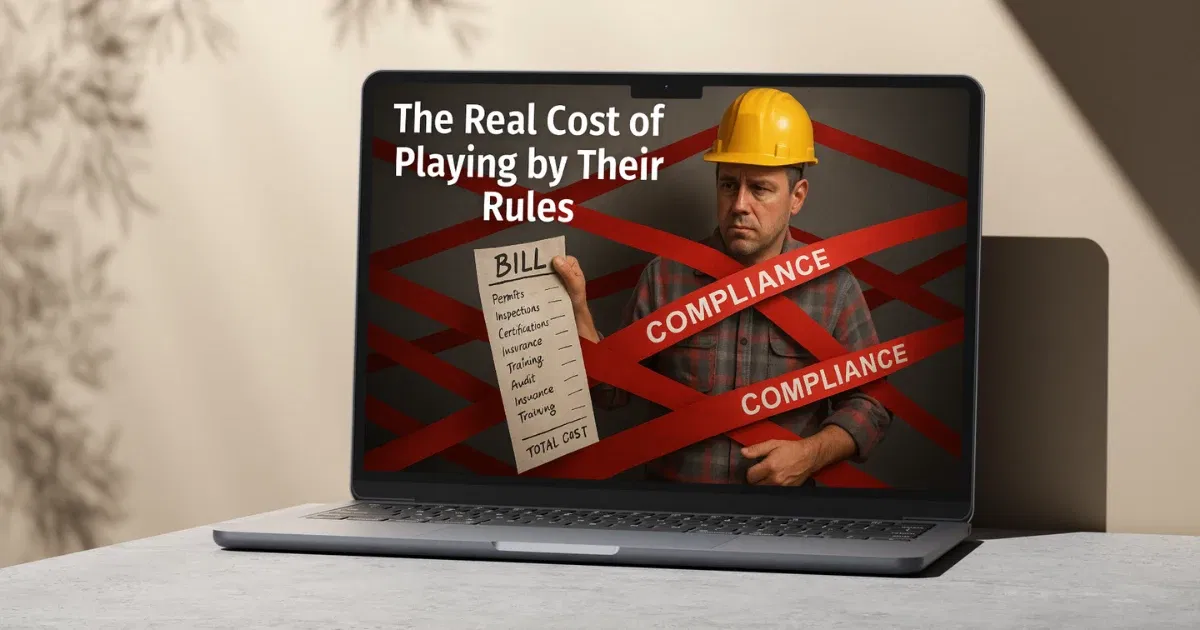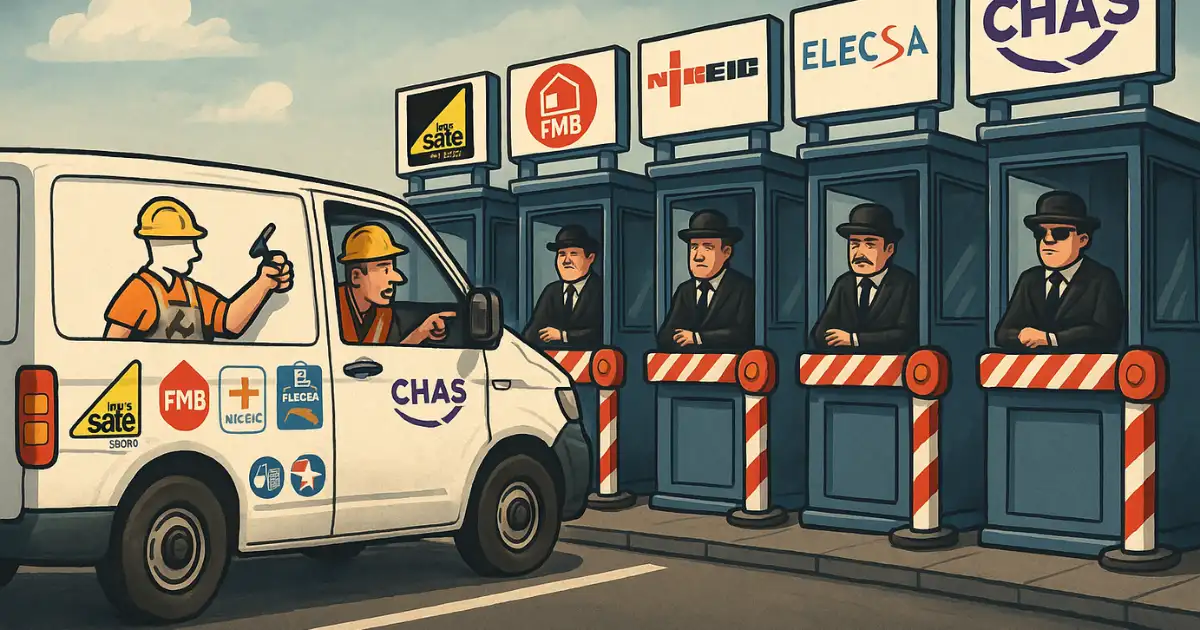For source references, see the note at the bottom of this article.

The Real Cost of Playing by Their Rules
Most people assume building regulations are about safety. Do the job right, get it signed off, move on.
But that’s not how it works any more.
These days, the rules don’t just make building harder, they make it more expensive, more confusing, and less about actual safety.
What started out as a way to keep cowboys off-site has ballooned into a compliance industry. One that thrives on endless forms, surprise inspections, made-up job titles, and fees that wear down anyone without a legal team and a spare £10k.
This isn’t about cutting corners, most decent builders want proper standards and fair checks.
The problem is, the standards keep shifting. The checks aren’t fair. And the only ones winning are the ones making money from the chaos.
Here’s where the real money’s going, and who’s actually paying the bill.
1. Building Control: From Oversight to Overreach
In 1990 a two-bed semi needed one council inspector, one visit, £200.
In 2024 the same house needs:
- Pre-app meeting (£300+)
- Full plans (£600+)
- Four separate inspections (£150 each)
- Part L energy calc (£400)
- Biodiversity Net Gain report (£1,200–£3,000)
- Fire-statement-for-a-bloody-semi (£800)
That’s £3,000–£5,000 before you’ve even broken ground, and half the time the inspector’s using the same tape measure your grandad used in ’78.
The council’s own LABC fee schedule 2024 lists “complex domestic” at £1,500–£2,800, but every extra “risk‑averse” request (a phrase used by risk consultants like Lichfields in 2023) adds another zero.
(Source: LABC fee guidance; risk‑averse quote from Lichfields blog)
Source breakdown and figures discussed in full here: Red Tape Driving Local Builders to Extinction

Whatever happened to common sense? Are these rules for safety… or PROFIT
2. Site Safety: From Sensible Precaution to a Billion-Pound Box-Ticking Circus
Site safety used to mean just that, keeping people safe. Brief the lads, watch your step, and look out for each other. We covered how that shifted here.
But over time, that common-sense approach has been replaced with something bloated and far less effective.
The HSE’s own stats show construction fatalities have barely changed since 2010: 39 deaths in 2010, 45 in 2023.
Yet, the market for compliance schemes like CHAS, SMAS, and SafeContractor is now estimated to be worth £1.2 billion a year.
Here’s what that circus looks like in three overpriced rings:
| Ring | Ticket Price | What It Actually Does |
|---|---|---|
| CHAS Premium | £1,025/yr | Uploads the same 12 docs you gave last year |
| Site Safety Plus | £195 course | Tells a 30-year scaffolder how to climb a ladder |
| Toolbox Talk App | £3 per worker/month | Sends a PDF of the talk you already gave at 7 a.m. |
Meanwhile, micro-firms (0–9 staff), which make up 91% of the UK construction sector, are drowning in admin. According to a CITB 2023 survey, these builders spend more than 20 days per year just on “safety paperwork.”
That’s £2,000 in unpaid admin time per person, enough to frame out a full extension, wasted on forms that do little to actually improve safety.
Source data from: HSE Fatal Injury Statistics 2010–2023, CITB Safety Administration Survey 2023, NAO Compliance Market Estimate 2024.
3. Mandatory Certification Schemes: A Quick Reality Check
We’ve already broken this one down in a full deep-dive here, but here’s the short version:
Builders across the UK are now expected to pay £800 to £1,600 a year just to keep up with badge schemes like CHAS, SMAS, SafeContractor, NICEIC, and more. That’s not for training or tools, that’s just to show a sticker on their van that says they’re allowed to work.
The kicker? These schemes haven’t reduced accident rates. The safety stats haven’t improved. And most clients never even check the logos.
So who’s cashing in? In many cases, it’s not the industry, it’s private-equity firms and holding companies that now own the badge providers.
For small builders, it’s another annual tax disguised as professionalism. For clients, it means inflated quotes and fewer builders able to compete for work.
4. Form-Filling & Audits: The Silent Productivity Killer
We broke down how compliance schemes waste time in this full post, but here’s what it looks like in one builder’s actual diary.
Shared anonymously by a Kent-based spark in 2024, it shows how just one tradesperson can lose over 40 hours a year to box-ticking admin that builds nothing.
| Task | Hours/yr | £££ lost @ £40/hr |
|---|---|---|
| CHAS renewal | 8 | £320 |
| PAS 2030 file updates | 12 | £480 |
| Constructionline PQQ (40 pages) | 16 | £640 |
| Uploading evidence for council | 6 | £240 |
| TOTAL | 42 hrs | £1,680 |
Based on SME spark diary (2024). Multiplied across 700,000 UK tradespeople, this equals over £1.4 billion lost in productive time.
That’s a full working week spent not wiring, plastering, roofing, or building. And it’s repeated across every SME in the sector, all for the sake of paperwork nobody on-site ever reads.
5. The Real Cost: It’s Not Just Builders Paying
Every extra report, badge, or box-tick doesn’t just hit builders, it hits everyone down the chain. Clients, renters, and taxpayers are footing the bill for a bloated system that’s lost touch with its purpose.
a) Homeowners
Homes for Scotland’s 2024 survey of SME home builders indicates that new energy-efficiency and safety regulations introduced since 2021 are adding ‘over £20,000 to the cost of each new home developed’.
And for anyone looking to extend their home? Planning-related evidence now adds £3,000–£5,000 before a single brick is laid.
b) Renters
The collapse of small builder numbers means fewer small sites get developed. That’s a direct cause of longer housing queues, slower builds, and higher rents.
c) Taxpayers
In 2023–24, the UK Construction Industry Training Board (CITB) collected £202 million in levy income. But just £66 million of that was spent on on-site apprenticeships and short courses.
Meanwhile, Transparency International UK’s latest review found that £8.8 billion is lost every year to fraud and inefficiency in local government procurement, driven in part by the very red tape these schemes were meant to prevent.
Source data from: Homes for Scotland Survey (2024), CITB Annual Report 2024, Transparency International UK Report 2024.

6. Big Firms vs. Little Firms – The Double Standard
When people say, “we all have to follow the same rules,” they’re not wrong, they’re just not telling the whole story.
Big companies don’t dodge the rules… they just have the money and manpower to breeze through them. SME builders, meanwhile, are drowning in the same sea of forms, audits, and badge schemes, without the lifeboat.
It’s the same system. But one side plays with accountants and admin staff. The other side plays with their own time, sanity, and unpaid hours.
If you think that’s exaggerated, look at this:
| Item | Small Builder (1 van) | National PLC (1 division) |
|---|---|---|
| CHAS fee | £1,025 | £20,000 umbrella covers 200 sites |
| Building Control visits | 4 × £150 | NHBC waiver (internal sign-off) |
| Audit burden | 42 hrs DIY | Full-time compliance team |
| Grant eligibility | £0 | £5,000/plot (Home Building Fund, badge-holders only) |
Source: Ai.4.Construction analysis based on builder interviews, LABC data, and previous blog breakdown here.
That’s not a level playing field. It’s a corporate express lane, and everyone else is stuck in paperwork traffic.
7. The Safety Stats That Don’t Move
For all the fees, forms, badges, and courses, you’d expect the results to speak for themselves.
But they don’t. In fact, the most telling numbers haven’t budged in over a decade. The stats on fatality, fire, and explosion are either flat… or worse.
Which raises the obvious question: if all this mandatory compliance was really about safety, shouldn’t the numbers be falling?
| Metric | Pre-badge era (2000–08) | Post-mandatory era (2016–23) | Change |
|---|---|---|---|
| Construction fatalities | 39/yr | 45/yr | +15% |
| Electrical fires | ~4,300/yr | ~4,100/yr | Flat line |
| Gas explosions (major) | 31 (2005–09) | 34 (2019–23) | +10% |
Source: HSE Fatal Injury Statistics 2010–2023, Home Office Fire Statistics, Gas Safe Register Report 2024.
If the stickers worked, the graphs would slope down. They don’t.
Source data from: HSE Fatal Injury Statistics 2010–2023, Home Office Fire Statistics, Gas Safe Register Report 2024.
8. How to Slash the Compliance Bill – A Builder’s Cheat-Sheet
This isn’t legal advice, and it’s not about cutting corners — but here’s what real builders across the UK are doing to cut down on paperwork and pointless fees.
| Red-tape Item | Hack | Typical Saving |
|---|---|---|
| CHAS / SMAS | Join a trade body that offers mutual recognition | £600–£800/yr |
| Building Control | Use the “minor works” category with your LA | £1,000–£2,000/job |
| Planning Evidence | Pre-app meeting + template reports | £1,500/job |
| NVQ Refreshers | Experienced Worker Route (EWR) | £1,200/person |
| Toolbox Talks | Free HSE PDFs + WhatsApp group | £200/yr |
Note: These savings are based on typical builder reports and public fee data. Use your own judgment. Not all methods are suitable for every job.
9. What Homeowners Can Do Tomorrow
This isn’t just a builder problem, if you’re planning a renovation, extension, or new build, here’s how to cut through the red tape and avoid wasting money:
- Ask for the “compliance” line-item in quotes. If it’s more than 5%, challenge it.
- Use local word-of-mouth, still the best vetting system in the game.
- Request mutual-recognition certs, councils often accept FMB or other trade-body equivalents.
- Vote with your wallet, every £1 spent with a local SME keeps more in the community than a national PLC.
TL;DR – The Sticker Translation Guide
Here’s how to read between the lines of those logos on the side of the van:
| Sticker Says | Translation |
|---|---|
| “Building Reg compliant” | Paid council £3k for the same inspector |
| “CHAS accredited” | Uploaded insurance for the 13th year running |
| “NVQ qualified” | Paid college £1,200 to watch a PowerPoint |
| “Real qualification” | 25 years on the tools, no fires, no leaks, happy customers |
Your reputation is your certificate. Everything else is just a toll booth.
Share this exposé. With your mates. With your family. With every builder and homeowner who’s sick of paying for nonsense that means nothing and lines the pockets of those who give nothing back. Because things will only change if we bring awareness and stand together.
Related Topics
All source documents referenced in this blog are maintained on our Verified Sources Page.
All source documents referenced in this blog are maintained on our Verified Sources Page.
